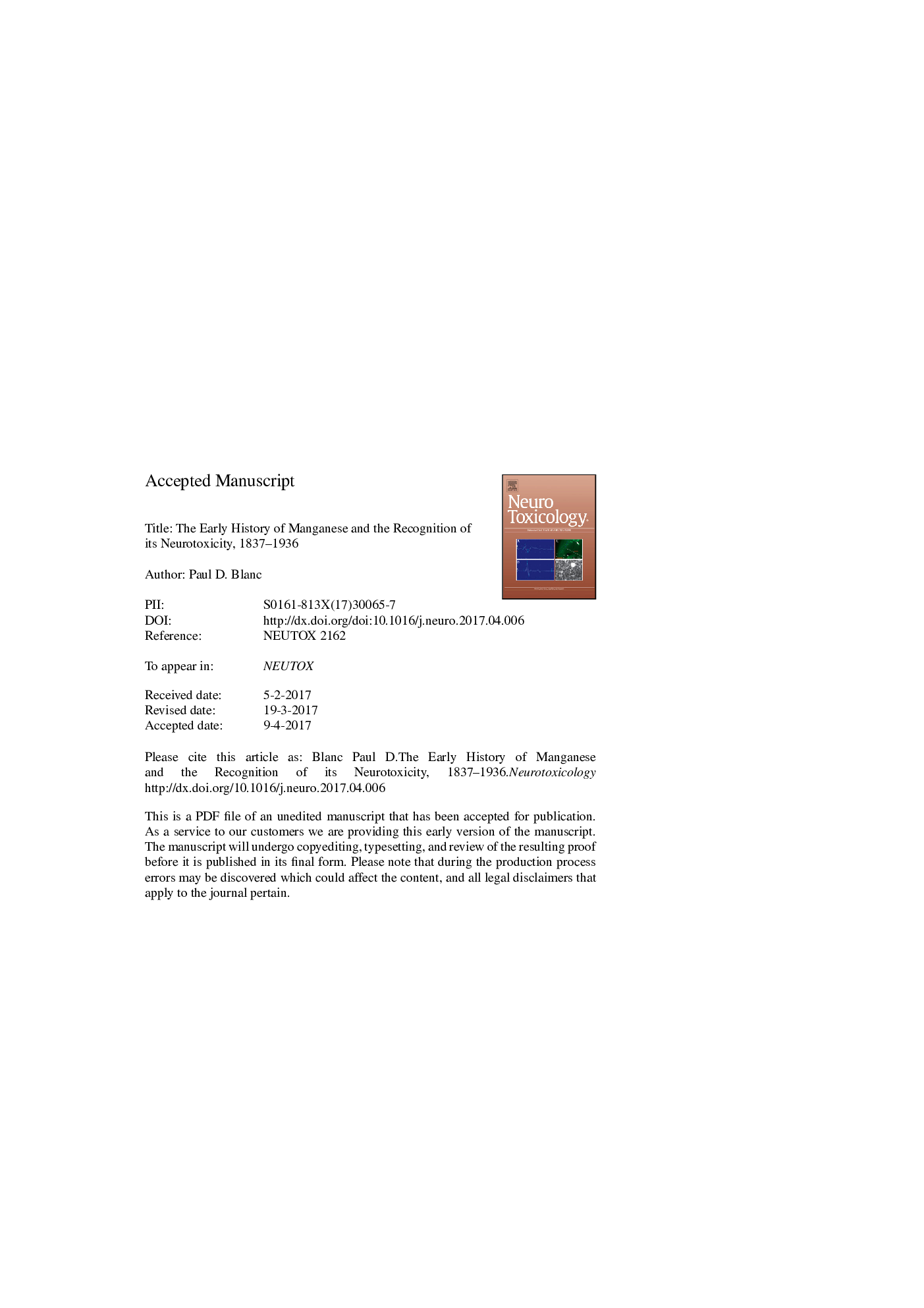| کد مقاله | کد نشریه | سال انتشار | مقاله انگلیسی | نسخه تمام متن |
|---|---|---|---|---|
| 8550300 | 1562030 | 2018 | 23 صفحه PDF | دانلود رایگان |
عنوان انگلیسی مقاله ISI
The early history of manganese and the recognition of its neurotoxicity, 1837-1936
ترجمه فارسی عنوان
تاریخچه اولیه منگنز و شناخت عصبی آن، 1936-1837
دانلود مقاله + سفارش ترجمه
دانلود مقاله ISI انگلیسی
رایگان برای ایرانیان
کلمات کلیدی
منگنز، عصبی عصبی، تاریخ، اصطلاح، آدم رقیق دژنراسیون لنزیکال،
موضوعات مرتبط
علوم زیستی و بیوفناوری
علوم محیط زیست
بهداشت، سم شناسی و جهش زایی
چکیده انگلیسی
The history of the biomedical recognition manganese-caused neurotoxicity mirrors changing technologies as much as it does the ontology of parkinsonism. The initial 1837 report of manganese-induced neurologic injury was made by John Couper, a university-based physician in Scotland. He made clear that the outbreak occurred among workers at the Charles Tennant bleach manufactory in the environs of Glasgow. The relatively new technology of chlorine generation using manganese accounted for the novel exposure involved. At the time, this factory was the largest hypochlorite bleaching powder producer in the world. As the 19th century progressed, technological change in steel fabrication requiring higher manganese content greatly increased demand for the metal. Nonetheless, more than six decades elapsed before the next reports of manganese neurotoxicity emerged. Two unrelated outbreaks (both on Continental Europe) were reported within weeks of each other in 1901, one by von Jaksch and the other by Embden. All the cases were heavily exposed to manganese-containing dust. By the eve of the First World War, a total of 9 patients with manganese-caused neurologic illness had been reported in five separate Continental European publications. Meanwhile, new technology led to another exposure source. Magnetic separation techniques allowed the extraction of zinc from mixed ore also containing iron and manganese, leading to exploitation of a unique source of high manganese-content ore found in New Jersey. Not long after that technology's introduction, in 1912 Casamajor reported the first U.S. cases of manganism, detailing classic findings. Additional cases from the same cohort were reported a few years later, with continued exposure driven by First World War-driven demand for manganese to be used in armaments. The nosology of chronic manganese neurotoxicity remained in flux, with considerable emphasis on shared attributes with Wilson's disease, a syndrome only then recently described. A landmark 1924 primate study by Mella showed manganese-induced basal ganglion damage; human autopsy study data in the years following further supported the view that manganese toxicity represented a parkinsonian syndrome. As the 1937 centenary of Couper's first report approached, newer technologies (electric arc welding and battery making) were being linked to manganese-caused disease, even as mineral extraction was expanding as a global source of exposure.
ناشر
Database: Elsevier - ScienceDirect (ساینس دایرکت)
Journal: NeuroToxicology - Volume 64, January 2018, Pages 5-11
Journal: NeuroToxicology - Volume 64, January 2018, Pages 5-11
نویسندگان
Paul D. Blanc,
